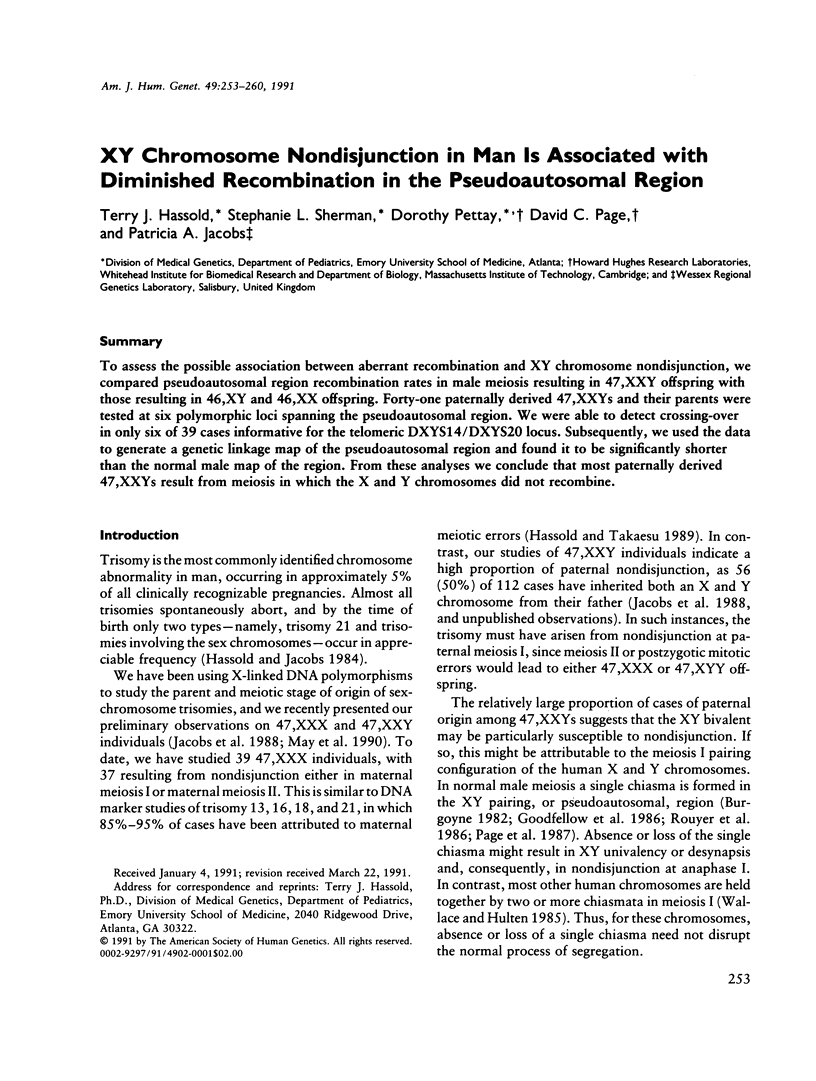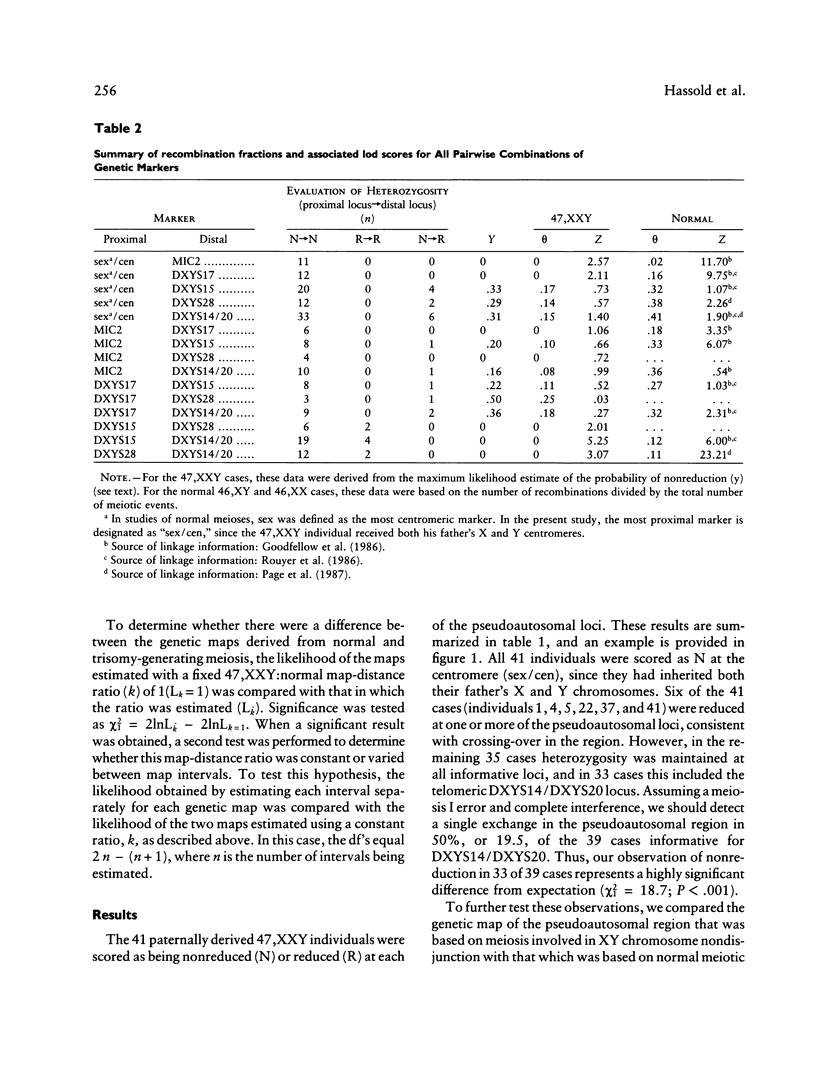Abstract
To assess the possible association between aberrant recombination and XY chromosome nondisjunction, we compared pseudoautosomal region recombination rates in male meiosis resulting in 47,XXY offspring with those resulting in 46,XY and 46,XX offspring. Forty-one paternally derived 47,XXYs and their parents were tested at six polymorphic loci spanning the pseudoautosomal region. We were able to detect crossing-over in only six of 39 cases informative for the telomeric DXYS14/DXYS20 locus. Subsequently, we used the data to generate a genetic linkage map of the pseudoautosomal region and found it to be significantly shorter than the normal male map of the region. From these analyses we conclude that most paternally derived 47,XXYs result from meiosis in which the X and Y chromosomes did not recombine.
Full text
PDF







Images in this article
Selected References
These references are in PubMed. This may not be the complete list of references from this article.
- Burgoyne P. S. Genetic homology and crossing over in the X and Y chromosomes of Mammals. Hum Genet. 1982;61(2):85–90. doi: 10.1007/BF00274192. [DOI] [PubMed] [Google Scholar]
- Chakravarti A., Majumder P. P., Slaugenhaupt S. A., Deka R., Warren A. C., Surti U., Ferrell R. E., Antonarakis S. E. Gene-centromere mapping and the study of non-disjunction in autosomal trisomies and ovarian teratomas. Prog Clin Biol Res. 1989;311:45–79. [PubMed] [Google Scholar]
- Goodfellow P. J., Darling S. M., Thomas N. S., Goodfellow P. N. A pseudoautosomal gene in man. Science. 1986 Nov 7;234(4777):740–743. doi: 10.1126/science.2877492. [DOI] [PubMed] [Google Scholar]
- Hassold T. J., Jacobs P. A. Trisomy in man. Annu Rev Genet. 1984;18:69–97. doi: 10.1146/annurev.ge.18.120184.000441. [DOI] [PubMed] [Google Scholar]
- Hassold T. J., Takaesu N. Analysis of non-disjunction in human trisomic spontaneous abortions. Prog Clin Biol Res. 1989;311:115–134. [PubMed] [Google Scholar]
- Hassold T., Benham F., Leppert M. Cytogenetic and molecular analysis of sex-chromosome monosomy. Am J Hum Genet. 1988 Apr;42(4):534–541. [PMC free article] [PubMed] [Google Scholar]
- Jacobs P. A., Hassold T. J., Whittington E., Butler G., Collyer S., Keston M., Lee M. Klinefelter's syndrome: an analysis of the origin of the additional sex chromosome using molecular probes. Ann Hum Genet. 1988 May;52(Pt 2):93–109. doi: 10.1111/j.1469-1809.1988.tb01084.x. [DOI] [PubMed] [Google Scholar]
- Kidd K. K., Bowcock A. M., Schmidtke J., Track R. K., Ricciuti F., Hutchings G., Bale A., Pearson P., Willard H. F., Gelernter J. Report of the DNA committee and catalogs of cloned and mapped genes and DNA polymorphisms. Cytogenet Cell Genet. 1989;51(1-4):622–947. doi: 10.1159/000132810. [DOI] [PubMed] [Google Scholar]
- May K. M., Jacobs P. A., Lee M., Ratcliffe S., Robinson A., Nielsen J., Hassold T. J. The parental origin of the extra X chromosome in 47,XXX females. Am J Hum Genet. 1990 Apr;46(4):754–761. [PMC free article] [PubMed] [Google Scholar]
- Morton N. E., Andrews V. MAP, an expert system for multiple pairwise linkage analysis. Ann Hum Genet. 1989 Jul;53(Pt 3):263–269. doi: 10.1111/j.1469-1809.1989.tb01793.x. [DOI] [PubMed] [Google Scholar]
- Morton N. E., Keats B. J., Jacobs P. A., Hassold T., Pettay D., Harvey J., Andrews V. A centromere map of the X chromosome from trisomies of maternal origin. Ann Hum Genet. 1990 Jan;54(Pt 1):39–47. doi: 10.1111/j.1469-1809.1990.tb00359.x. [DOI] [PubMed] [Google Scholar]
- Page D. C., Bieker K., Brown L. G., Hinton S., Leppert M., Lalouel J. M., Lathrop M., Nystrom-Lahti M., de la Chapelle A., White R. Linkage, physical mapping, and DNA sequence analysis of pseudoautosomal loci on the human X and Y chromosomes. Genomics. 1987 Nov;1(3):243–256. doi: 10.1016/0888-7543(87)90051-6. [DOI] [PubMed] [Google Scholar]
- Rao D. C., Morton N. E., Lindsten J., Hultén M., Yee S. A mapping function for man. Hum Hered. 1977;27(2):99–104. doi: 10.1159/000152856. [DOI] [PubMed] [Google Scholar]
- Rouyer F., Simmler M. C., Johnsson C., Vergnaud G., Cooke H. J., Weissenbach J. A gradient of sex linkage in the pseudoautosomal region of the human sex chromosomes. Nature. 1986 Jan 23;319(6051):291–295. doi: 10.1038/319291a0. [DOI] [PubMed] [Google Scholar]
- Shahar S., Morton N. E. Origin of teratomas and twins. Hum Genet. 1986 Nov;74(3):215–218. doi: 10.1007/BF00282536. [DOI] [PubMed] [Google Scholar]
- Wallace B. M., Hultén M. A. Meiotic chromosome pairing in the normal human female. Ann Hum Genet. 1985 Jul;49(Pt 3):215–226. doi: 10.1111/j.1469-1809.1985.tb01695.x. [DOI] [PubMed] [Google Scholar]
- Warren A. C., Chakravarti A., Wong C., Slaugenhaupt S. A., Halloran S. L., Watkins P. C., Metaxotou C., Antonarakis S. E. Evidence for reduced recombination on the nondisjoined chromosomes 21 in Down syndrome. Science. 1987 Aug 7;237(4815):652–654. doi: 10.1126/science.2955519. [DOI] [PubMed] [Google Scholar]



